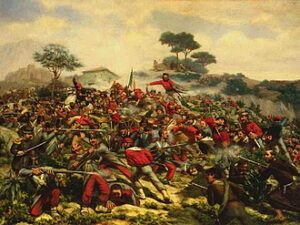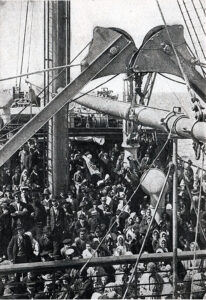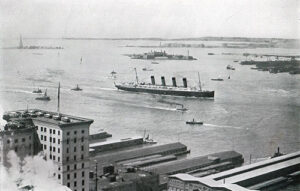Immigration
Why Did So Many Immigrate around 1900
Though Sicilians immigrated at other times as well, the main thrust of Sicilian immigration to the United States took place between 1880 and 1920. But why?
The Risorgimento – Unification
There were many reasons for mass emigration from Sicily around that time, but the main one from which most of the others stem was the fallout that resulted from Il Risorgimento, the Unification of Sicily and Italy. In fact, the unification led to increased poverty in Sicily, decreased opportunity, and a mass exodus of a large number of its people who realized that at that time, at least some of them had to go and seek opportunity elsewhere if they wished to survive.
Below is an image of the Battle of Catalafimi, one of several sieges that took place as Garibaldi marched through and declared himself Dictator of Sicily.

There were large transfers of property and power at that time as well, as many who had any wealth or power in Sicily were stripped of it, and it was, in turn, handed over to opportunists. Sicilians had to pay high taxes to Italy, and they were also suddenly required to participate in compulsory military service on behalf of Italy.
Rather than being forced to go fight for Italy, some preferred to fight for Sicily – to protect it and to protect their people from Italy. There were some attempts to do so within the first decade or so of unification. They were harshly put down, and as things got worse, many chose to do whatever it took to leave.
Poverty and feudalism were problems too and contributory, but that had been the case in Sicily for a while.
The main change that happened at this point though, coinciding with mass emigration (particularly in the earlier years) from the homes and country that their families had lived in for centuries was Il Risorgimento and the increased poverty and problems that stemmed from it.
As Sicilians immigrated to America, however, and wrote back of the better opportunities there (far better than any could hope to obtain in Sicily at the time), other friends and families from their hometowns came to join.
There was significant emigration in the 1920s as well, but that was under Mussolini and there were different factors at play. Also, in the 1920s, laws changed that slowed immigration into the United States.
Emigration from Sicily

Departing from the homeland. Ah, but how to do so? Tickets on a passenger ship to the United States were extremely expensive even in the steerage section (the worst class that could be traveled in, especially in the earlier years of immigration), and far out of the reach of most people, many of whom were the poorest and most desperate and desirous of going.
In some families, they did whatever they could to pull the money together to send even one family member over. Extended families would even pitch in, sending a member they felt would be most likely able to work and save and help the others. Once that family member had made some money in the United States (far more than he was able to make in Sicily at the time), he could either return to Sicily, or he could send money for more of his family to come to the United States.
Contract labor was also a factor for some immigrants who saw that as their only option. It continued even after declared a cause for deportation if discovered. That is why one of the questions on the passenger ship records from those days asked who bought their ticket. The usual and expected response was “by her” or “by him,” or sometimes it says father or husband. If the person said that an employer or anyone who had offered them a job had paid for it, they were immediately deported back to Sicily. Nonetheless, many did arrive under those conditions, but they learned not to state it during entry interrogations.

How Much
Although prices would vary at different times, steerage was typically around $40 or somewhere thereabouts. In today’s money, they were paying close to a thousand dollars. True, we might pay around that now to fly to Italy, but the conditions and treatment they endured in steerage class of a passenger ship were nothing like what we experience in travel today. The voyage typically took at least 3 weeks, and the conditions were often quite wretched particularly in the earlier years. Some improvements took place by or around the 1920s.
They were also required to have some money on them, as being a pauper or a likely ward of the state was not acceptable for entry and could also be grounds for immediate deportation. That is why one of the questions you can see on the passenger ship records from those years asks how much money they have on them. It would only be acceptable for them to have none if family already living in the United States were coming to meet them and could provide for them, i.e. a husband or father. The immigrants would not be released though and would be held in detention until he arrived which sometimes took days if, for example, he had to travel by train to the port of entry
Birds of Passage
Not all who immigrated to the United States stayed. Some at the time would immigrate, work a season and save up some money, then return to Sicily and share that money with their families to help support them. Some of them did that once; others took several trips back and forth across the ocean, each time bringing back more money to give to their families and put into their communities. In such a way, they were able to not only survive (when otherwise they may not have been able to), in some cases they were also able to actually thrive.
They had to invest money into the ticket to do so, but the money they made in the United States as opposed to what they could make in Sicily meant that even with the high price of the ticket, if they worked hard in America, they would still come out ahead of anything they could try to attain in Sicily at the time.
And how much would it cost them to return to Sicily for those who chose to do so? Below is an example from an ad in the Times Picayune for a ship leaving New Orleans for Italy on October 18, 1910.
There were a few cabins left with rates from $70 to $80. Steerage class (which is the way many Italian immigrants traveled) was $38. According to inflation calendars, that $38 converts to over $1,000 in 2020 dollars!


Those Who Stayed Permanently
In most cases, the whole family did not immigrate to the United States at the same time. Usually a male would immigrate first (head of household and/or a son), get work, and save money.
If he decided to stay and/or if other family members were desirous of joining, often he would send the money for their passage. That would usually be the case if he were sending for his wife and children. But sometimes he would send fare for other extended family member(s) and/or others he knew back in his hometown, and they could pay him back after they arrived and earned money. In some cases, entire branches ended up immigrating to the United States around that time.
Over time, some lost touch with their relatives or heritage back in Sicily. There were many reasons for that, but one of the main reasons was probably language. As Sicilian immigrants to America assimilated to the ways and conventions in their new home country, many quit speaking the language of their homeland and/or their descendants stopped speaking it.
Consequently, of those who immigrated in the early years, many of the younger were never taught the language. The immigrant’s children would have known it, but not their grandchildren or their great grandchildren.
And here’s the thing: our ancestors spoke Sicilian. An ancient language which preceded even Italian, yet Garibaldi and his Unification measures were already attempting to eradicate it from use and to overwrite it with the Italian language even as our ancestors fled.
So even though Italian was being imposed prior to their emigration, they were still speaking Sicilian. Letters I’ve seen are combinations of Sicilian and Italian.
That is likely why some descendants of Sicilian immigrants lost touch – language barrier. Because even at points where some would have liked to have reconnected – or may have even traveled to the homeland in attempt to do so, some were limited by an inability to communicate.
As more gain pride and appreciation for their Sicilian Heritage, more have been learning the languages of not only Italian but Sicilian as well. As both languages are now spoken throughout Sicily, learning at least a little of either or both will go a long way in helping anyone connect with their Sicilian Heritage and also with their family’s past.
Videos
Below is a Video of Immigrants arriving at Ellis Island
(Restored with added sound)
And though this isn’t about Sicilians in particular, this next video does provide information and help give visual about steerage and third class ship travel, which was the way that many Sicilians traveled from Sicily during the immigration wave between 1880 and 1930.
If you’d like to hear stories of the voyage, how long it took, what it was like, etc here are two accounts, might add a few more.
Palermo to New Orleans 1900
Palermo to New Orleans 1903